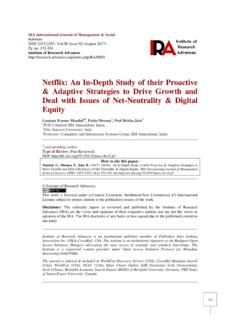Transcription of STP: Segmentation, Targeting, and Positioning
1 STP: segmentation , targeting , and PositioningChapter 92 Outline the different methods of segmenting a market Describe how firms determine whether a segment is attractive and therefore worth pursuing Articulate the differences among targeting strategies: undifferentiated, differentiated, concentrated, or micromarketing Define Positioning and describe how firms do itTod ay3 The big pictureCompanyCompetitionCorporate partnersSegmentTa r g e t i n gPositioningProductPlacePromotionPriceCu stomer acquisitionCustomer retentionPROFITM arketing analysis(understanding your business)Creating valueCapturingvalueCONSUMERS4 STP ProcessImportant for group projects5 segmentation strategy MUST be consistent with Firm s mission/objective Firm s current situation (SWOT)Step 1.
2 Establish overall vision or objectives for your marketing strategy6 segmentation strategy MUST be consistent with Firm s mission/objective Firm s current situation (SWOT)Step 1: Establish Overall Vision or Objectives for your Marketing Strategy Coca-Cola s objective is to increase sales in a mature industry. If this is our researchshould we be doing about our consumer? our consumer? benefitsis he/she seeking?The above questions lead you through the STP MethodSample SegmentsGeographicContinent: North America, Asia, Europe, Africa.
3 Within the United States: Pacific, mountain, central, south, mid-Atlantic, northeastDemographicAge, gender, incomePsychographicLifestyle, self-concept, self-valuesBenefitsConvenience, economy, prestigeBehavioralOccasion, loyaltyStep 2: segmentation Methods8 Geographic segmentation Consumers organized on the basis of where they liveStep 2: segmentation 2: segmentation Methods10 Psychographic segmentation Consumers organized on the basis of lifestyle and valuesStep 2: segmentation Methods11 Behavioral segmentation Consumers organized on the basis of how they use the product/serviceStep 2: segmentation Methods12 Behavioral segmentation Consumers organized on the basis of how they use the product/serviceStep 2: segmentation 3: Evaluate Segment Attractiveness15 Step 3: Evaluate Segment AttractivenessIdentifiable Who is in their market ?
4 Are the segments unique? Does each segment require a unique marketing mix?16 Step 3: Evaluate Segment AttractivenessSubstantial Too small and it is insignificant can you create an effective message to reach the segment in question? Too big and it may be impossible to craft a message that resonates equally with all the members of your chosen segment ! Effective segmentation is critical, even if your product has a general market 3: Evaluate Segment AttractivenessKnow the product existsUnderstand what it can do Recognize how to buy18 ResponsiveStep 3: Evaluate Segment AttractivenessReact positively to firm s offeringAccept the firm s value propositionTrust your firm!
5 (Reputation, ethics)Customers in each segment must:Benefits to be received from a product or service 19 ProfitableStep 3: Evaluate Segment AttractivenessHomeownersBusinessesSegmen t size75,0001,000 Segment adoption percentage1%20%Purchase behavior Purchase price Frequency of purchase$10012 times$50020 timesProfit margin percentage60%80%Fixed costs$400,000$1,000,000 Segment profit$140,000??Important for group project!Profitable20 ProfitableStep 3: Evaluate Segment AttractivenessHomeownersBusinessesSegmen t size75,0001,000 Segment adoption percentage1%20%Purchase behavior Purchase price Frequency of purchase$10012 times$50020 timesProfit margin percentage60%80%Fixed costs$400,000$1,000,000 Segment profit$140,000$600,000 Important for group project!
6 Profitable21 There are several targeting strategiesStep 4: Selecting a Target MarketTa r g e t i n g b r o a d l yTa r g e t i n g n a r r o w l yUndifferentiatedDifferentiatedMicromark etingConcentratedMass marketing22 Assume a restaurant is trying to market its new business. Using a differentiated marketing strategy, the restaurant can appeal to the college crowd by marketing cheap specials on food and drinks, the family crowd by marketing kid-friendly meal options and table entertainment and to the elderly by marketing senior discounts and early-bird specials.
7 Using a concentrated marketing strategy, the restaurant can market its convenient location to a group of residents within 10 miles of the business. Using an undifferentiated marketing strategy, the restaurant can highlight its grand opening example23 Step 4: Selecting a Target Market24 Step 4: Selecting a Target MarketWhole food target market Working parents, aged approximately 30 to 50 Diverse, multi-cultural, embrace opportunities to try new foods Environmentally-conscious Sustainability, animal welfare, organically-grown foods are among these consumers shopping priorities City and suburban Educated professionals ( , , MBA, , etc.)
8 Seeking premium service Willing to pay premium prices for a specific grocery-shopping experience25 STP26 Positioning methods Value (relationship price to quality) Salient attributes Symbol CompetitionWhat sets your product or service apart from the others (unique value proposition)?You already offer what they offer, but your company takes it to the next level!Step 5: Develop a Positioning Strategy27 STP28 Perceptual map Display, in 2+ dimensions, the position of the product in the consumer mind , Car brandsPositioning methods29Te sl a e x a m p l


